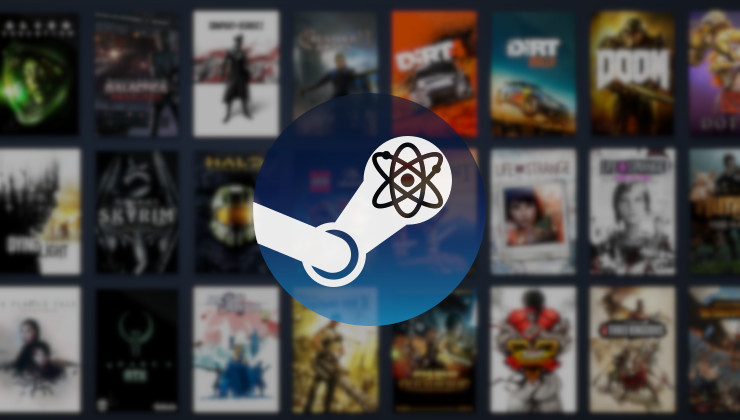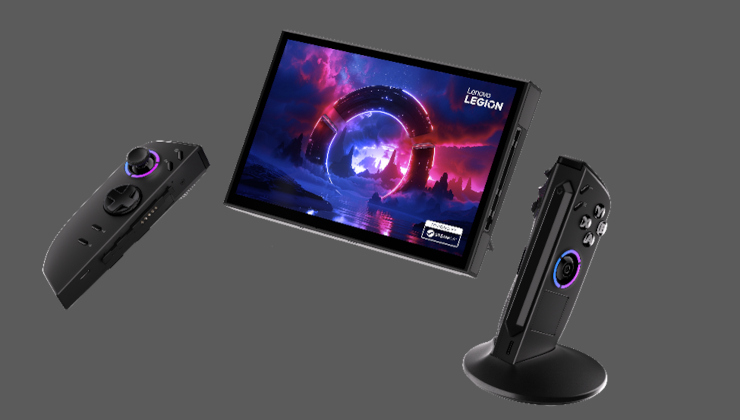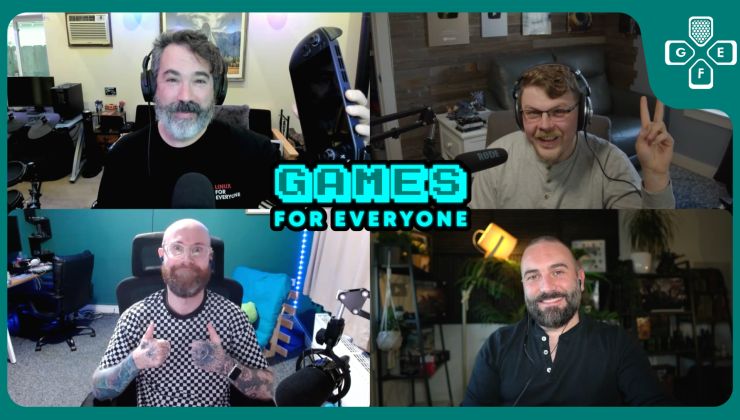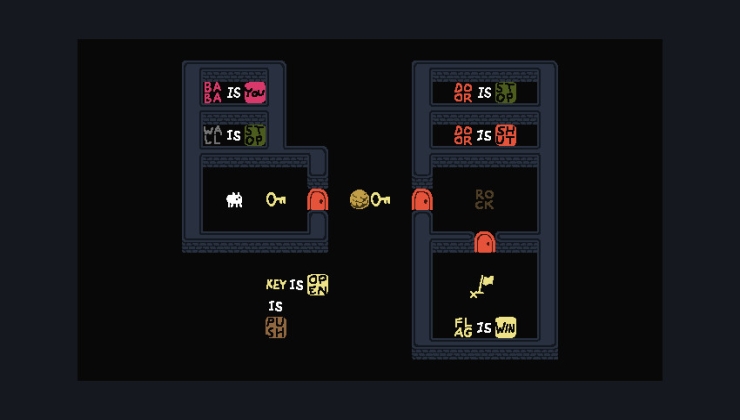You've all seen the rumours by now, and apparent confirmation from Ars that Valve has been working on the SteamPal, a Linux powered handheld that could be released this year. Here's a short list of what we want from it.

Steam Machines and SteamOS were ultimately a failure, for many reasons. The whole thing was confusing for both users and consumers with multiple models, and most of them wanted far too much money. What will be different this time? How can Valve actually make it work?
This time around at least, it looks like Valve are entering a market that's still relatively in its infancy. However, it's clearly popular with more hardware vendors showing prototypes and the GPD Win series continues showing how a smaller vendor can make it happen. If Valve really do enter, they would be positioned well considering they know how to produce their own hardware after the Steam Controller, Steam Link and now the Valve Index too. Doing it directly with only one model or perhaps two with a higher model would already solve a lot of their original Steam Machine issues. Let's say that's the first thing we want: make it clear. Get the marketing right this time, and actually continue marketing it unlike before.
Game support is something that suffered originally. We had porters like Feral Interactive and Aspyr Media come onboard thanks to Steam Machines but they simply weren't enough. This time, we have a vast library of supported indie games, a couple AA/AAA and then there's Steam Play Proton too. However, realistically, we still need that direct support and porting effort from developers to ensure the games work as good as they can on the hardware, especially since this won't be top-end stuff. Still, with Proton, there is at least that ability to play more than what's supported and the ability to is vitally important to make a SteamPal actually worth even thinking on to purchase.
Having good game support is the single most essential thing. People don't want to wait around for shaders to compile when you hit play, stuttering while Proton/DXVK builds up a cache will be very noticeable on the hardware too and no doubt be the source of many poor reviews. Having developers build and optimize for it will end up essential to making it a win overall.
Another serious point to think on is online gaming. This is a sore spot right now. I can only imagine the reviews of "you can't play x or y, the most popular online games" which will be due to the likes of Easy Anti-Cheat and BattlEye. Perhaps though, since Valve will fully control the kernel they can have it all signed in a particular way that anti-cheat systems can hook into it. However, that could then split things between desktop Linux and a SteamPal. It's both exciting to think on for support and concerning.
A Steam Game Pass, yup, something like that I think would be in some way needed. Other consoles have a form of it, Valve allows it on Steam already with the likes of EA Play, it would make sense for Valve to have one to not only pull in even more money but to give users access to a library of games right away for a SteamPal when they signed up. Either that, or team up with a bunch of developers to give free copies to those who buy one.
Keep the desktop mode. Please. That was actually a highlight of SteamOS originally. You get the console-like experience, with the option to dive into a normal desktop if you want to do other things. That would extend the possibilities of what you can do with a Valve SteamPal. I think removing that would be a mistake, as long as they lock-down the SteamPal SteamOS side of things so that users can't break it and as easy system-refresh option to set things back to normal.
Send loads out to developers long before release. Gosh I hope they're doing this. How do you get people interested in supporting it? Give them developer kits. Other console makers do this for good reason.
Some form of external streaming media support out of the box. Yes, I know, that the main point is gaming but we're long past the point of such single-use devices. People will expect the likes of Netflix and others to work. So get it sorted before release. It was a sore spot for the original Steam Machines.
I don't think I really need to put down "use a Linux operating system" as a thing we want from it do I? It's pretty obvious it will be. So, SteamOS 3? Let's say I want that to be real and to still allow others to download it and install it just like they could before. Oh, and duh: please don't be a failure.
Don't be too big. I can't stress this enough. The Nintendo Switch is just about right (except the terrible to hold Joy-Cons that is when in portable mode). Any bigger and it would be far too unwieldy and likely defeat the point. That is one thing I am genuinely worried about. Valve could get a little too screen-happy with it but I hope they're being smart about this one.
Just a few thoughts to get it out there to stop the mind from spinning on it, no doubt we will all have more we want and expect from it over time. They key though is to not expect too much. It is, after all (if real), a handheld! We can't expect magic from it, as it will be limited in terms of what power it can cram into the casing.
Over to you in the comments: what do you want from it?
Quoting: NoStI think Valve will need to whitelist a lot more games for Proton before releasing the device.Most games have to be ported for it in the same way as for other consoles, I think. But I also think that the developments of the last five years have made that much easier. Much easier than porting a game like The Witcher 3 to the Switch, for example.
You can't expect the users of a portable console to be tinkering with the Proton version or command options.
I hope they are already working on it. Otherwise it could become a source of many negative reviews.
Quoting: BeamboomFor sure, I can't talk for all, but personnally, it's exactly the fact that I tried to play games on my phone with the Steam Link app that made me crave for a full fledge handheld... To me, mobile gaming is sub-par or with ports of old titles that I have already played, a while back. Imo, saying that handhelds is a dead market might miss the mark... It's probably that nobody found the right combination... Selling a handheld with basic hardware specs at 1000$ just doesn't make sense... Imo, in the handheld market, Nintendo never had any valuable competition (even the PS Vita, from reviews I read, back then). I still believe that Valve is in a good position if they put the marketing and support right.Quoting: MohandevirMobile gaming? You mean like in Android playstore games? Because these are two different breeds of players. I, for one, never ever considered mobile games. Candy crush, June's Journey and touch screens in general are not my kind of fix. My wife though... :)You need to look into what's actually available for iPhone and Android. It's every single genre. There's RPGs, mmos, strategy games, adventure games, action, puzzle, you name it. Even ported PC games. For instance, Rockstar has put all their earlier Grand Theft Auto games on there. Republique (stealth, great game) is another example.
But this also boils down to what we actually want to play on small gaming devices. Back in the PSP days I had a TON of PSP games, all sorts. But my favourite games on that machine were indeed all small, quick, fun games that worked perfectly on a small device.
Quoting: MohandevirWhat about the Nintendo Switch? With the Wii U, Nintendo was on the verge of going under... The Switch saved themThis is why I wrote further up in my replies:
Quoting: BeamboomThe market will see this as yet another attempt to breath new life into an old market segment that's pretty much dead unless your name is Nintendo.They are the one single instance that survived the fall of the market of handheld gaming devices. An amazing example, but there's an agreement that it was the insanely strong catalogue of IPs in their fold and their long standing rock solid reputation on portable gaming devices that made this to be even remotely possible.
Remember, Nintendo is primarily a handheld gaming company. That's their home turf. I'm not so sure that a bunch of PC games have that same ability to push handhelds. But we shall see!
Quoting: MohandevirImo the real deal is marketing... Mass products are requiring mass marketing (including support). This thing must be available everywhere it's possible and be advertised on every inches of all visible walls. That's how it usually works.But the product must also resonate with the market. Sony pushed a hell of a massive marketing power behind the Vita. They had a 100% dedication on that device for years after the rest of us declared it dead in the water.
But they were not Nintendo. They didn't have that insanely strong brand for HANDHELD gaming devices. Even after the great success that were the PSP!
Just in my close circle of friends, I discussed about the SteamPal to Windows gamers, and it raised a lot of interest, even when I told them it would probably be Linux based (with Proton). It wasn't the same kind of reception with the Steam Machines at all, at that time (even I couldn't find a reason to buy one). It feels like many PC players are ready to get onboard, but are waiting for the right offering (performance/price). But like I said in my other post, gaming hardware is a competitive market. Can't say that you're point of view is wrong either, but I believe that the handheld market is not as dead as many would like it to be (Nintendo probably likes that point of view) and there may be an opportunity for Valve to fill the gap.
Time wil tell... But this time, I'm getting ready to be in the starting blocks, if Valve hit the "sweet spot".
Last edited by Mohandevir on 14 Jun 2021 at 3:47 pm UTC
Quoting: MohandevirTime wil tell... But this time, I'm getting ready to be in the starting blocks, if Valve hit the "sweet spot".So [this](https://www.pcgamer.com/uk/onexplayer-handheld-pc-performance-gaming-review/) is the sort of target for a "handheld gaming PC." I think that something from Valve could solve a lot of its shortcomings.
I'm sure this device's 2560x1600 display is lovely, but it isn't able to hit that as a render target, pretty much ever. Dropping that to 1080p or 1920×1200 in the same sort of size will help it run at native res more of the time. Gamescope should be able to do a better job of upscaling than a third party using Windows when the device can't render at native res, too, as well as having the ability to run at 30 fps capped, say, without needing to change the game itself.
Xe is better than older AMD integrated graphics, but RDNA 2 is rumoured to be better still. We haven't had a shootout at the very low TDPs yet, though.
LP-DDR5 should have much better bandwidth at lower power draw than the DDR4 used in that device. I suspect that it will still need 16 GB, though, even at 1080p - less seems like too much corner cutting, which would hamper its longevity.
I think that Valve, as a long-term partner of AMD and (hopefully) getting economies of scale, would be able to get a much better price for the components than a crowdfunded company getting them retail from Intel. Valve also don't need to necessarily make a profit on the hardware. They won't want to make a loss, but they aren't relying on profits from the hardware to stay in business. That means that the price to customers of a Valve device should be quite a lot lower.
As I understand it, Windows is free if the screen is small, so the licence price isn't an issue for a handheld. They won't want to use Windows, anyway, though. It caused limitations for that other device. Valve can control the entire running environment of the games as well as the drivers and user interface, which a third party relying on Windows simply can't.
Quoting: CatKillerSeriously, at 8", I wouldn't be surprised if 720p was enough (I would try it, at least)... It would have the benefit of allowing higher framerates... Just a theory, and I might change my mind if I ever come to own one, but on my 5.6" phone, there is near to no visual difference between 720p and 1080p, while shooting/jumping/fighting, but it's a lot smoother in 720p (Steam Link). :wink:Quoting: MohandevirTime wil tell... But this time, I'm getting ready to be in the starting blocks, if Valve hit the "sweet spot".So [this](https://www.pcgamer.com/uk/onexplayer-handheld-pc-performance-gaming-review/) is the sort of target for a "handheld gaming PC." I think that something from Valve could solve a lot of its shortcomings.
I'm sure this device's 2560x1600 display is lovely, but it isn't able to hit that as a render target, pretty much ever. Dropping that to 1080p or 1920×1200 in the same sort of size will help it run at native res more of the time. Gamescope should be able to do a better job of upscaling than a third party using Windows when the device can't render at native res, too, as well as having the ability to run at 30 fps capped, say, without needing to change the game itself.
Xe is better than older AMD integrated graphics, but RDNA 2 is rumoured to be better still. We haven't had a shootout at the very low TDPs yet, though.
LP-DDR5 should have much better bandwidth at lower power draw than the DDR4 used in that device. I suspect that it will still need 16 GB, though, even at 1080p - less seems like too much corner cutting, which would hamper its longevity.
I think that Valve, as a long-term partner of AMD and (hopefully) getting economies of scale, would be able to get a much better price for the components than a crowdfunded company getting them retail from Intel. Valve also don't need to necessarily make a profit on the hardware. They won't want to make a loss, but they aren't relying on profits from the hardware to stay in business. That means that the price to customers of a Valve device should be quite a lot lower.
As I understand it, Windows is free if the screen is small, so the licence price isn't an issue for a handheld. They won't want to use Windows, anyway, though. It caused limitations for that other device. Valve can control the entire running environment of the games as well as the drivers and user interface, which a third party relying on Windows simply can't.
Last edited by Mohandevir on 14 Jun 2021 at 4:35 pm UTC
Quoting: MohandevirPretty sure the Switch is 720p unless Docked, then it upscales to 1080p (and not even on all games).Quoting: CatKillerSeriously, at 8", I wouldn't be surprised if 720p was enough (I would try it, at least)... It would have the benefit of allowing higher framerates... Just a theory, and I might change my mind if I ever come to own one, but on my 5.6" phone, there is near to no visual difference between 720p and 1080p, while shooting/jumping/fighting, but it's a lot smoother in 720p (Steam Link). :wink:Quoting: MohandevirTime wil tell... But this time, I'm getting ready to be in the starting blocks, if Valve hit the "sweet spot".So [this](https://www.pcgamer.com/uk/onexplayer-handheld-pc-performance-gaming-review/) is the sort of target for a "handheld gaming PC." I think that something from Valve could solve a lot of its shortcomings.
I'm sure this device's 2560x1600 display is lovely, but it isn't able to hit that as a render target, pretty much ever. Dropping that to 1080p or 1920×1200 in the same sort of size will help it run at native res more of the time. Gamescope should be able to do a better job of upscaling than a third party using Windows when the device can't render at native res, too, as well as having the ability to run at 30 fps capped, say, without needing to change the game itself.
Xe is better than older AMD integrated graphics, but RDNA 2 is rumoured to be better still. We haven't had a shootout at the very low TDPs yet, though.
LP-DDR5 should have much better bandwidth at lower power draw than the DDR4 used in that device. I suspect that it will still need 16 GB, though, even at 1080p - less seems like too much corner cutting, which would hamper its longevity.
I think that Valve, as a long-term partner of AMD and (hopefully) getting economies of scale, would be able to get a much better price for the components than a crowdfunded company getting them retail from Intel. Valve also don't need to necessarily make a profit on the hardware. They won't want to make a loss, but they aren't relying on profits from the hardware to stay in business. That means that the price to customers of a Valve device should be quite a lot lower.
As I understand it, Windows is free if the screen is small, so the licence price isn't an issue for a handheld. They won't want to use Windows, anyway, though. It caused limitations for that other device. Valve can control the entire running environment of the games as well as the drivers and user interface, which a third party relying on Windows simply can't.
Quoting: 1xokI think the whole purpose of Steam Proton was not to force the developers to port their games to a specific platform (Linux in this case). It's supposed to be a "magic" tool that just makes everything work with a couple of clicks.Quoting: NoStI think Valve will need to whitelist a lot more games for Proton before releasing the device.Most games have to be ported for it in the same way as for other consoles, I think. But I also think that the developments of the last five years have made that much easier. Much easier than porting a game like The Witcher 3 to the Switch, for example.
You can't expect the users of a portable console to be tinkering with the Proton version or command options.
I hope they are already working on it. Otherwise it could become a source of many negative reviews.
Otherwise Steam Pal would lose one of its strongest potential selling points, which is having access to your (almost) entire Steam library.
I believe that's the purpose of the whitelist system. Steam already knows which version of Steam Proton you need to run a specific game and automatically selects it when installing the game.
The problem is that the whitelist is currently very short (less than 100 titles, I think). That's why it needs to be expanded.
Quoting: Horie.g. the only reason I know about handheld PS consoles is because when I was little a guy in my school had one (the rich f***) .... one guy, in an entire school - a big schoolEven my former girlfriend, who was not into games at all, knew both Playstation Portable and Nintendo DS.
They might have been popular in certain specific areas... but it doesn't really matter.
Nintendo DS sold 154 million, more than any console except PS2:
https://de.statista.com/statistik/daten/studie/160549/umfrage/anzahl-der-weltweit-verkauften-spielkonsolen-nach-konsolentypen/
Quoting: HoriThey never entered the mainstream though, and it was long ago.I guess you're very young.
The Nintendo Game Boy iterations were *massive*, like total world domination, for a long long time, to a greater degree that the Switch is today. If I remember correctly the market for Game Boy games were much bigger than the market for Playstation games, back then.
Nintendo created handheld gaming with the Game&Watch machines released back in 1980, and handheld gaming esblished itself in the mainstream from then on. They sold SHITLOADS of'em. Every kid I knew in the 80s had at least one.
I would summarise with handheld gaming being a mainstream thing - especially in Japan but also globally - all the way up until the smartphone took over that market. Then it died extremely abrupt.
Last edited by Beamboom on 15 Jun 2021 at 11:43 am UTC
Quoting: BeamboomThe Nintendo Game Boy iterations were *massive*, like total world dominationAbsolutely.
And before it, there were the single game handhelds...
Quoting: BeamboomI would summarise with handheld gaming being a mainstream thing - especially in Japan but also globally - all the way up until the smartphone took over that market. Then it died extremely abrupt.I thought of it in waves. Game boy, world domination, then nothing notable, PSP and DS, nothing again, smartphones.
Last edited by Eike on 15 Jun 2021 at 12:51 pm UTC
Personnally, I think that dockable handhelds are quite a new thing and it's really interresting. In my point of view, it's like a laptop specialized and dedicated to gaming, which is exactly what I'm looking for. For other tasks, I got other devices. Anyway, it's not because you think it's dead that it cannot be revived, if given the right presentation and features.
Remember in the early 2000's? PC gaming was supposed to be dead... :whistle:
Last edited by Mohandevir on 15 Jun 2021 at 12:45 pm UTC
Quoting: MohandevirI just don't believe in the smartphone argument... There is nothing to see there, imo. Gaming directly on a smartphone is sub-par and the screens are too small...It doesn't appeal to me either, but you should ask Feral Interactive, I guess they've got (more information than us combined and) a different opinion on this matter...
Quoting: EikeNot saying that selling games on mobile can't be profitable... I'm just saying that your are not targeting the same audience. PC handhelds never ever happened at the right price bracket. Valve is in a postion to do that... Nobody else.Quoting: MohandevirI just don't believe in the smartphone argument... There is nothing to see there, imo. Gaming directly on a smartphone is sub-par and the screens are too small...It doesn't appeal to me either, but you should ask Feral Interactive, I guess they've got (more information than us combined and) a different opinion on this matter...
Last edited by Mohandevir on 15 Jun 2021 at 12:58 pm UTC
Quoting: NoStThe problem is that the whitelist is currently very short (less than 100 titles, I think). That's why it needs to be expanded.The thing with the whitelist was that Valve themselves took on the official support of running it in Proton; the devs were off the hook entirely, and if they released an update (Steam is primarily a tool to get everyone's game updated, after all) that broke the game in Proton, Valve were left holding the bag. They can't keep doing that indefinitely.
Instead, the Proton github contains compatibility reports for thousands of games. They know, for each game, which versions of Proton work (and they're very bothered by any regressions), and they know which settings are necessary. They'll also know all the specifics of the device: hardware, driver version, kernel version, specific runtime. I think they'll use that to initially populate their list of compatible games. But if a game is going to keep its "compatible" tag then the game devs themselves are going to have to test each update in the specific environment for the handheld before it goes live, and remedy it if it doesn't work. I think Valve are happy to collaborate on that process, and make it as easy as possible for the game devs, but they won't want to do all the work, nor have all the liability.
Quoting: HoriObviously you wouldn't see your strategy games there since they don't (IMO: can't) work with a controllerThe right touchpad on the Steam Controller worked pretty well as a mouse substitute. I expect the handheld will have that. The left one didn't work that well as a D-pad substitute, so I don't know if it will have one of those. Maybe if they go with the swappable modules they have a patent on. The display is also expected to have a touchscreen. I think that the touchpad/touchscreen combination should work well for a lot of strategy games. Particularly fiddly or particularly information-dense ones won't likely be great, but I can see something like Civ or something like Northgard being fine.
Quoting: CatKillerI was going to say this same thing. With a portable device, you have whatever controller scheme they put on there, plus the potential for touch screen controls as well.Quoting: HoriObviously you wouldn't see your strategy games there since they don't (IMO: can't) work with a controllerThe right touchpad on the Steam Controller worked pretty well as a mouse substitute. I expect the handheld will have that. The left one didn't work that well as a D-pad substitute, so I don't know if it will have one of those. Maybe if they go with the swappable modules they have a patent on. The display is also expected to have a touchscreen. I think that the touchpad/touchscreen combination should work well for a lot of strategy games. Particularly fiddly or particularly information-dense ones won't likely be great, but I can see something like Civ or something like Northgard being fine.
Hell, only having a game pad hasn't stopped ports of Command and Conquer (for example) to the Playstation, etc. Yeah playing RTS games with a gamepad is chunky, but perfectly possible. Even more so with something like the Steam Controller.
Valve have put TONS of effort into making PC gaming more gamepad friendly. Between that and lazy console -> computer ports of games, there are a ton of games that have full controller support these days.
I'm hoping the 'SteamPal' has some sort of modularity to the controller though, being able to hot swap buttons and control sticks around like the Thrustmaster eSwap controller would be amazing!
Quoting: slaapliedjeI'm hoping the 'SteamPal' has some sort of modularity to the controller though, being able to hot swap buttons and control sticks around like the Thrustmaster eSwap controller would be amazing!Yeah, that could be awesome. Having button blocks, D-pad blocks, touchpad blocks, and stick blocks that you can swap out, to suit your taste (not having to choose between GameCube-style and PlayStation-style) or for easy replacement when they get sticky or whatever. They might find that it adds too much cost to the build, or are too fiddly at the size they need to be, though, so that's in my nice-to-have list rather than something that I'm particularly expecting.
Quoting: EikeAnd before it, there were the single game handhelds...That's the ones! Notice the square logo on the upper left of the lower panel. Those are the "Game & Watch" games I mentioned. They were huuuuuge in the 80s. There were quite a few of them, both of the single and double screen types, and we traded them at school so that everyone could get to play all the games available.
External Media: You need to be logged in to view this.
Last edited by Beamboom on 15 Jun 2021 at 7:32 pm UTC
Quoting: BeamboomThose and the Game Boys dominated. Even though the Lynx and the Game Gear or Nomad were full color. Granted all of the portables ate through batteries like crazy!Quoting: EikeAnd before it, there were the single game handhelds...That's the ones! Notice the square logo on the upper left of the lower panel. Those are the "Game & Watch" games I mentioned. They were huuuuuge in the 80s. There were quite a few of them, both of the single and double screen types, and we traded them at school so that everyone could get to play all the games available.
External Media: You need to be logged in to view this.











 How to setup OpenMW for modern Morrowind on Linux / SteamOS and Steam Deck
How to setup OpenMW for modern Morrowind on Linux / SteamOS and Steam Deck How to install Hollow Knight: Silksong mods on Linux, SteamOS and Steam Deck
How to install Hollow Knight: Silksong mods on Linux, SteamOS and Steam Deck